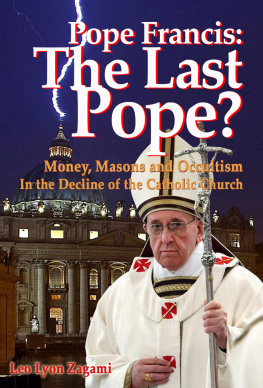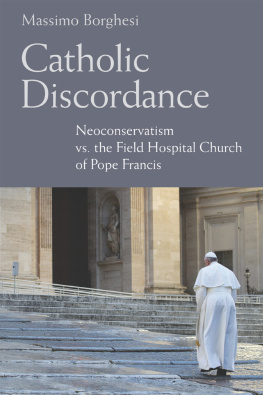1. The Introduction
Contemporary Taiwan can be said to have experienced a turning point in 1949 offering challenge as well as development. This was seen both internally and externally in economic growth, cross-strait relations and political maturity in party alternation, a first attempt in the long history of China. A modern Taiwanese scholar, Yang Rubin*, held more or less the same opinion about the 1949 Civil War in China as Dickens evaluation of the French Revolution (Yang , 5156).
This volume follows Yangs argument to discuss how the Taiwan Catholic Church, after 1949, became the surrogate church for the Mainland where religious persecution was taking place. The Taiwan Church developed practically from a mission territory under the jurisdiction of Dominican Fathers to a Church with seven Catholic dioceses. Then it was entrusted by the Pope to be a bridge between Mainland Catholics and the universal Church helping them to avoid becoming heretical and cutting themselves off from the universal Church.
In 1982, the Italian Fr. Angelo Lazzaretto published The Catholic Church in Post-Mao China (Lazzaretto ), a first glimpse of a multifaceted China and the Catholic Church awakening to new life. The newly established Holy Spirit Study Center in Hong Kong diocese purposefully studied the revival of the Catholic Church on the Mainland after the Cultural Revolution. Its bimonthly, semi-academic bulletin Tripod began to publish up-to-date information and comments on the Catholic Church in the Peoples Republic of China (PRC). On an international level, the opening up of China with a certain degree of religious revival aroused immense interest among international academics.
In 1992, a work on Sino-Vatican relations was published by Cambridge University Press, in which Taiwans role was briefly mentioned (Leung , 169187).
The transformation of Taiwan society after 1949 did not arouse the attention of international scholarship in religious studies. Even the transformation in 1948 of the Taiwan Church from a mission territory with a very minute cluster of some 3,000 rural and aboriginal believers and 15 clergy into a local church of 7 dioceses in 1969 with 809 priests and 300,000 urban Catholics did not arouse an interest in studying the Taiwan Catholic Church which, of course, included the Catholic Church diaspora from the Mainland. The neglect of Taiwan Catholic affairs by international scholarship was due to the prevalence in the seventies of pro-socialist sentiment in the West which did not respect the relocated Nationalist government in Taiwan after its defeat in the Civil War (19451949). In the study of Taiwans religions by Clark and Jones in 2003, the Catholic Church was only briefly mentioned without a chapter devoted to it, while Buddhism and the Presbyterian Church each merited a whole one (Clark and Jones
After more than 50 years of Catholic Church life in democratic Taiwan, it is time for local Catholic scholars to look back on the development of the Taiwan Catholic Church, to review its achievements and to evaluate its role with actors in religious organizations outside its boundary (the Catholic Churches in the Mainland, Hong Kong and Macau), sovereign states (the Vatican, Japan and Mainland China) as well as with the government of Taiwan through the lens of the social sciences and the humanities.
Since it is a groundbreaking research in English on the Taiwan Catholic Church, it is our hope that more international scholars will be attracted in days to come to delve more deeply into ecclesiastical soil revealing more meaningful Catholic issues to enhance the studies on the Catholic Church in the Greater China Region.
This volume discusses the development of the Catholic Church in Taiwan after the 1949 Civil War in China with the influx of well over one million Mainlanders into Taiwan. They included Catholic Church personnel scattered over the vast territory of China arriving to escape from religious persecution under Communist rule. Thus, the change of the societal and political landscape in Mainland China as well as in Taiwan allowed the Catholic Church of Taiwan to turn a new page in its development after the 1949 Civil War in China.
Traditionally, many discussions on religion including Catholicism are in the disciplines of theological and biblical studies. Their research writings are replete with theological and biblical terms which attract only Catholic readers who are used to the Catholic culture within the church milieu. The tensions in the continuous changes and sustainable development in contemporary Taiwan with its Catholic Church since the 1950s demand an understanding of Catholic and Taiwan relations from a better perspective, from different angles, through various academic disciplines such as international relations, history, sociology, law, philosophy politics and tourism.
Although the time frame of this volume is from 1949 after the Nationalist government (of China) moved to Taiwan to the present, yet the roots of the Taiwan Catholic Church have to be identified before the current church-state issues can be discussed in a proper historical context. Thus, the development of the Catholic Church in Taiwan vis--vis the coming of Spanish missionaries and the Japanese influence within the Church during the Japanese occupation period will be reviewed. Then the rapid development between the 1950s and 1970s with the influx of clergy and religious from Mainland China with its pros and cons after the Chinese Communist Party took over the Mainland will be analyzed. Taiwan-Vatican relations deserve special attention since they have come under the shadow of Sino-Vatican relations, the Vatican being the only European state which has diplomatic relationships with Taiwan. The contribution of Taiwan Catholics to the Bridging Endeavor with Mainland Catholics has never previously been analyzed and should not escape our attention. Catholic higher education in Taiwan deserves description because it is the only place in the Greater China Region providing authentic Catholic education radiating Catholic values. A new lay movementthe Focolarecoming from Italy, coincided with the stimulus of the Second Vatican Council (Vat II). Its function in Taiwan adds extra human resources to the Churchs evangelization . For this, the Focolares contribution to Taiwan will be discussed. Cooperation between the Church and the Taiwan government for the development of the pilgrimage site in Wanjin is one of several concrete cases to illustrate the Catholic Churchs external relations with the Taiwan government.
The Early Catholic Church in Taiwan: Its Foreign Relations
Spanish missionaries from the Philippines came to Taiwan in 1622 to establish the first Catholic mission there. The Portuguese did not stop the Spaniards from landing in Taiwan which was under the shadow of the Portuguese Padroado at the time (Ha , 7580). For the Portuguese, the most important halfway port on its Far East sea route was Macau, not Taiwan. Taiwan for them was a barren island of little value lying outside the Chinese continent, so they did not interfere with the missionary thrust of the Spaniards.
The Taiwan Catholic Church began to grow from 1622 to 1642 with a group of Spanish missionaries coming from the Philippines. They settled first in the Keelung and Tanshui districts targeting the natives of the Pingpu* clan. However, before they could expand their mission to other parts of Taiwan, they were forced to leave, being expelled by the Protestant Dutch who invaded Taiwan in 1642. In fact, the Spanish missionary achievement was very limited during these 24 years (Kuo , 3772). From the very beginning of the Taiwanese Catholic mission, its existence and development depended entirely on the international relations of two rival foreign states, Spain and Holland. Two hundred years later, in 1858, the Tianjin* Treaty was signed between the French and Qing* officials allowing mission work to resume in China. Thus, the Spanish lost no time in returning to Taiwan in 1859, this time in the persons of Dominican missionaries; they settled down in the south which became a mission territory of the Dominicans with the support of the same Dominican mission in Fujian Province. Here again, it is worth noting that the rebirth of the Catholic Church in Taiwan with the re-entry of Dominican missionaries in the nineteenth century also depended on international relations between the Qing Dynasty and western powers.












